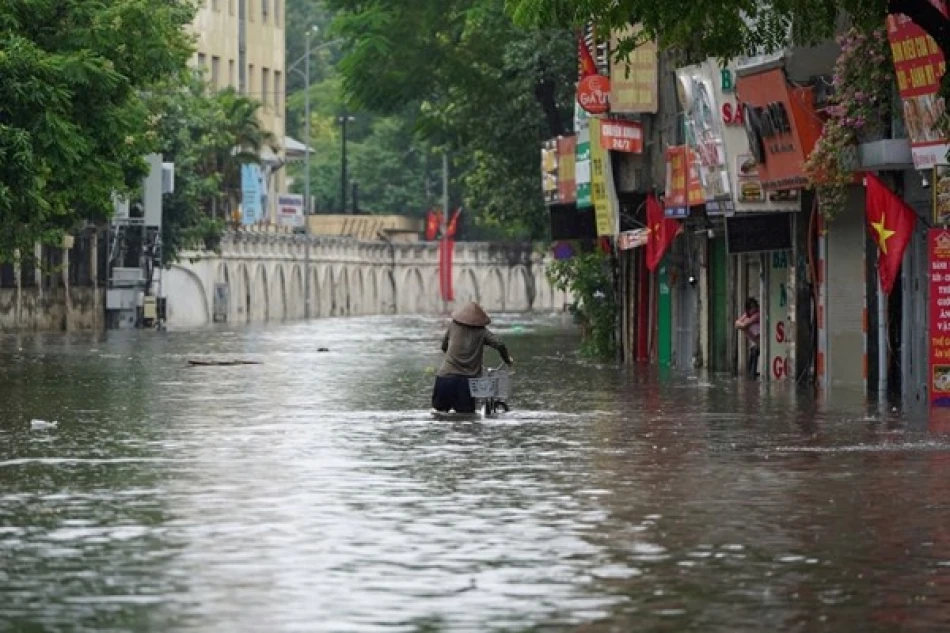
Deadly Typhoon Kujiki Wreaks Havoc in Vietnam's Capital Hanoi
Typhoon Kajiki Exposes Vietnam's Infrastructure Vulnerabilities as Climate Risks Intensify
Vietnam is grappling with widespread damage from Typhoon Kajiki, which claimed at least three lives and injured ten others while exposing critical weaknesses in the country's infrastructure. The storm's impact on agricultural land, power grids, and urban drainage systems highlights growing concerns about Southeast Asia's preparedness for increasingly severe weather events driven by climate change.
Immediate Damage Assessment Reveals Broad Economic Impact
Vietnamese authorities reported extensive destruction across multiple sectors following Kajiki's landfall on Monday afternoon along the north-central coast. The typhoon damaged approximately 7,000 homes and submerged 28,800 hectares of rice paddies—a significant blow to Vietnam's agricultural sector, which employs nearly 40% of the country's workforce.
The storm's fury extended beyond residential areas, toppling 18,000 trees and destroying 331 electrical poles. This infrastructure damage triggered widespread power outages across several provinces, disrupting both residential and commercial activities in a country increasingly dependent on stable electricity for its growing manufacturing base.
Hanoi Flooding Exposes Urban Planning Challenges
Dramatic images from state media showed Vietnam's capital, Hanoi, severely flooded during Tuesday morning's heavy rainfall. The flooding underscores persistent urban drainage problems in a city of over 8 million people, where rapid development has often outpaced infrastructure improvements.
This flooding pattern mirrors challenges faced by other major Southeast Asian cities like Jakarta and Manila, where inadequate drainage systems struggle to cope with intense rainfall events that are becoming more frequent and severe.
Regional Context: Southeast Asia's Growing Storm Vulnerability
Kajiki's impact reflects a broader trend affecting the entire Southeast Asian region, where typhoons are becoming more intense due to warmer ocean temperatures. The Philippines, which regularly faces 15-20 typhoons annually, has invested heavily in early warning systems and evacuation procedures—measures that Vietnam may need to expand as storm intensity increases.
Unlike more developed economies such as Japan or South Korea, which have implemented sophisticated typhoon-resistant infrastructure, Vietnam's rapid economic growth has sometimes prioritized speed over resilience in construction and urban planning.
Economic Implications for Vietnam's Growth Trajectory
The agricultural damage from Kajiki strikes at the heart of Vietnam's food security and export economy. Rice production contributes significantly to the country's agricultural exports, and the loss of nearly 29,000 hectares of rice paddies could affect both domestic supply and international commitments.
For international investors and manufacturers who have increasingly viewed Vietnam as an alternative to China for production bases, repeated infrastructure disruptions from severe weather events represent a growing risk factor. Companies may need to factor climate resilience into their supply chain planning more seriously.
Infrastructure Investment Priorities Shifting
The widespread power outages highlight Vietnam's need for more resilient electrical infrastructure. As the country continues its transition toward renewable energy and attempts to attract energy-intensive industries like data centers and semiconductor manufacturing, grid reliability becomes increasingly critical.
Regional competitors like Thailand and Malaysia have made significant investments in storm-resistant power infrastructure, potentially giving them advantages in attracting climate-sensitive industries.
Looking Forward: Adaptation Becomes Essential
As Kajiki weakened into a tropical depression while moving through Laos on Tuesday morning, Vietnamese authorities face the immediate challenge of recovery and the longer-term imperative of building climate resilience. The storm's relatively modest classification yet significant impact suggests that even moderate weather events can cause substantial damage to inadequately prepared infrastructure.
Vietnam's response to this crisis—particularly how quickly it restores power and agricultural productivity—will serve as a test case for the country's disaster management capabilities as climate change continues to intensify regional weather patterns.
Most Viewed News

 Layla Al Mansoori
Layla Al Mansoori






